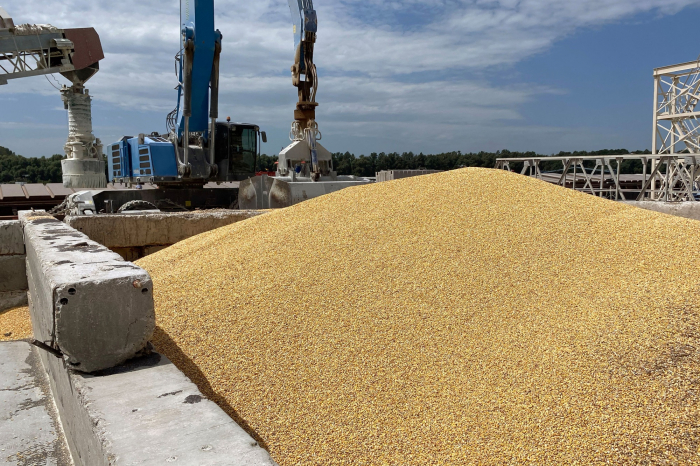Ukraine is exporting about five million tonnes of grain a month - much more than in the summer of 2023, when Russia pulled out of the Black Sea grain deal.
Russia stopped giving safe passage to cargo ships going to and from Ukraine in July of that year, and as a result, the country's grain exports slumped.
How much grain is Ukraine exporting?
Ukraine exported 5.8 million tonnes of grain in February 2024, and 5.3 million tonnes in January.
However, the amount exported in March dropped back - with 4.5 million tonnes sent between 1 - 27 March.
Before Russia's invasion in 2022, the country was sending about 6.5 million tonnes abroad every month.
After Russia pulled of the Black Sea Grain Initiative (or "grain deal"), it said it would view any vessel bound for Ukraine as a potential military target.
Few cargo ships dared to go to Ukrainian ports, and monthly grain exports fell to just over 2 million tonnes in July, August and September 2023.
However, Ukraine has since established new export routes.
Between the end of the grain deal in July 2023 and the end of February 2024, it shipped about 20 million tonnes of grain to 42 countries, according to the country's vice prime minister Oleksandr Kubrakov.
This is despite 30 Russian attacks on Ukrainian grain ports and storage facilities since the deal ended.
Why do Ukrainian food exports matter?
Before Russia's invasion in February 2022, Ukraine was the world's seventh largest exporter of wheat, fourth largest exporter of barley, and the biggest exporter of sunflower seeds (used for sunflower oil and feed).
When the war started, Ukraine's exports slumped and world prices for grain soared. This particularly affected people in the world's poorest countries.
The more grain that Ukraine has been able to supply to global markets, the lower prices have gone.
Foodstuffs are a major earner for Ukraine. In 2021, the year before Russia's invasion, it made $27.8bn (£23.8bn) from exports.
What are Ukraine's new routes for grain exports?
Under the grain deal, cargo ships travelled to and from Ukrainian ports along a 357-mile (574km) corridor across the Black Sea to the Bosphorus Strait.
After that deal ended, Ukraine established a new "temporary export corridor" in August 2023, which hugs the western coastline.
This is a relatively safe route for cargo ships because the waters there are too shallow for Russian submarines to operate.
It also passes through the territorial waters of Romania and Bulgaria, two Nato countries.
Under the EU's "solidarity lanes" scheme, Ukraine is also sending grain by land and barge to ports on the River Danube, or to the Romanian port of Constanta, to be loaded onto cargo ships which then travel through the Black Sea.
More Ukrainian grain is also being exported to Europe to be sold on arrival, or to be shipped onwards from other European ports.
How has Ukraine responded to Russia's naval blockade?
Ukrainian armed forces have carried out repeated attacks on Russian naval ships and bases in the Black Sea, using aerial drones, sea drones and long-range missiles.
Ukraine's navy claims it has hit or disabled a third of all the ships in Russia's Black Sea fleet since the war began.
This has meant Russia is now putting fewer ships near the Ukrainian coast to blockade it.
What problems have Ukraine's grain exports caused in neighbouring countries?
To help Ukraine's economy after the Russian invasion, the EU scrapped tariffs on imports from the country.
However, countries in eastern Europe complained that this meant Ukrainian grain was flooding their markets, lowering wholesale prices and hitting the incomes of their farmers.
Some dealers had decided to sell the grain in these countries rather than ship it overseas from other European ports.
According to the EU's agriculture commissioner, Janusz Wojciechowski, 4.1 million tonnes of Ukrainian grain entered Poland between April 2022 and March 2023, and 3.4 million tonnes of that stayed in the country.
In May 2022, the European Commission introduced a ban on Ukrainian grain sales in Poland, Slovakia, Hungary, Romania and Bulgaria, only allowing grain meant for transit to enter those countries.
It lifted the restrictions in September 2023, saying the problem had been solved.
However, Poland has since imposed its own ban on Ukrainian grain imports, and Polish farmers have been blockading border crossings with Ukraine.
In March 2024, the European Commission proposed a cap on duty-free imports of some Ukrainian produce, including oats, eggs, poultry and sugar.
However it confirmed that all other Ukrainian imports into the EU - including wheat and barley - would remain free of duties until at least June 2025.
It is also proposing to increase tariffs on imports of Russian and Belorusian grain to reduce surpluses in eastern European countries.
BBC
More about:
















































